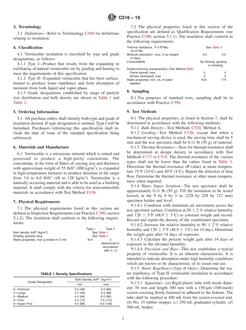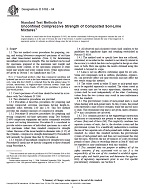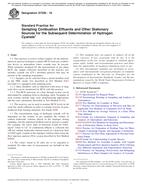1.1 This test method covers a procedure to identify asbestos in samples wiped from surfaces and to provide an estimate of the concentration of asbestos reported as the number of asbestos structures per unit area of sampled surface. The procedure outlined in this test method employs an indirect sample preparation technique. It is intended to disperse aggregated asbestos into fundamental fibrils, fiber bundles, clusters, or matrices. However, as with all indirect sample preparation techniques, the asbestos observed for quantification may not represent the physical form of the asbestos as sampled. More specifically, the procedure described neither creates nor destroys asbestos, but it may alter the physical form of the mineral fiber aggregates.
1.2 This test method describes the equipment and procedures necessary for wipe sampling of surfaces for levels of asbestos structures. The sample is collected onto a particle-free wipe material (wipe) from the surface of a sampling area that may contain asbestos.
1.2.1 The collection efficiency of this wipe sampling technique is unknown and will vary among substrates. Properties influencing collection efficiency include surface texture, adhesiveness, and other factors.
1.2.2 This test method is generally applicable for an estimate of the concentration of asbestos structures starting from approximately 1000 asbestos structures per square centimetre.
1.3 Asbestos identification by transmission electron microscopy (TEM) is based on morphology, electron diffraction (ED), and energy dispersive X-ray analysis (EDXA).
1.4 This test method allows determination of the type(s) of asbestos fibers present.
1.4.1 This test method cannot always discriminate between individual fibers of the asbestos and nonasbestos analogues of the same amphibole mineral.
1.4.2 There is no lower limit to the dimensions of asbestos fibers that can be detected. However, in practice, the lower limit to the dimensions of asbestos fibers, that can be detected, is variable and dependent on individual microscopists. Therefore, a minimum length of 0.5 m has been defined as the shortest fiber to be incorporated in the reported results.
This test method does not purport to address all of the safety concerns, if any, associated with its use. It is the responsibility of the user of this test method to establish appropriate safety and health practices and determine the applicability of regulatory limitations prior to use.
Product Details
- Published:
- 12/10/1999
- Number of Pages:
- 15
- File Size:
- 1 file , 170 KB


